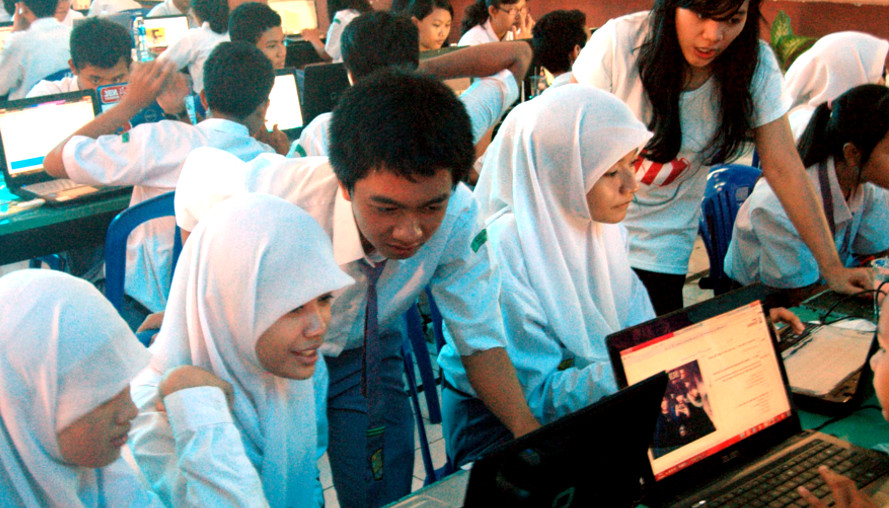- June 8, 2015
- Posted by: Totok Soefijanto
- Category: Blogs, Education, Featured

Information technology has become a necessity in our classrooms. The break-neck speed at which technological innovations are changing business and society puts serious pressure on national education systems.
Governments around the world recognize this and are modernizing their schools and curricula to train a future workforce that can compete in an increasingly connected and tech-dependent world. Simply putting technology in the classroom is insufficient; we need better technology adoption policies.
Twenty years ago, teaching kids to type quickly was considered sufficient digital training. Today’s job market sets the digital literacy bar far higher. Job seekers need command over word-processing and productivity software (such as Microsoft’s Office 365 suite), myriad online communication platforms, a basic understanding of programming, digital graphics and design, online marketing and branding and a rapidly changing array of mobile devices. These skills are no longer add-ons; they are the new fundamentals.
Indonesia’s neighbors have recognized this. In 2014, the government of Thailand launched the Technology Master Plan for Education, which is the country’s national plan to increase student access to digital learning. In Malaysia, since 2001, the government has invested heavily in computerization and training teachers to use ICT in the classroom. One result has been Malaysia being among the region’s early movers for online education. Today, Malaysia’s biggest e-learning institution, the Open University of Malaysia, has over 100,000 enrolled students.
Nevertheless, Indonesia is catching up. Indonesia’s Open University (UT) has 585,700 students enrolled across the archipelago. A significant number of UT students take ICT-based courses.
While Indonesia often prides itself on being a leader in the region, in terms of technological advancement, the country is only in the middle of the pack.
Last year, the World Economic Forum ranked Indonesia 77th out of 144 countries in terms of technological readiness, behind both Malaysia and Thailand. Furthermore, there has been under-investment in infrastructure throughout the country’s 6,000 inhabited islands, making it very challenging to provide the reliable electricity and Internet connectivity necessary for a successful digital education program. Of the 208,000 primary and secondary schools in Indonesia, roughly 90,000 operate without Internet connectivity and 17,000 operate without electricity.
Despite these challenges, Indonesia today is well positioned to make significant improvements to digital learning in the classroom over the next few years.
President Joko “Jokowi” Widodo has made it clear that K-12 education is a key reform priority for his administration. Soon after taking office last year, Culture and Elementary and Secondary Education Minister Anies Baswedan announced plans for the Indonesia ICT-Based Learning Movement, which aims to provide tablet devices for every K-12 student in Indonesia to prepare them for a technology-oriented workforce.
In his keynote address at a recent policy roundtable entitled “Harnessing Innovative Technology to Drive 21st Century Education across the Indonesian Archipelago,” Anies stated that “the presence of technology must be [in the classroom] to create innovations in the way we teach[…]and to close the [education] gap”.
He added that learning should take local factors into account; teachers must be trained properly in using ICT with a reliable support system. Otherwise, the technology will remain in the cupboard or inventory case.
The initial near-term response to the minister’s call to action should be using technology to improve teaching methods. Despite primary school enrollment rates of 92 percent in 2012, Indonesia’s education system is not producing sufficient learning outcomes, largely because it tends to be excessively teacher-centered and focused on rote memorization.
In terms of technological advancement, Indonesia is only in the middle of the pack.
Technology should be used to significantly reduce the cost and improve the quality of professional teacher training. Where currently teachers must travel days to regional training programs, cheaper and more regular collaboration and development can now be done through online video conferencing tools. Stanford University School of Education emeritus professor Larry Cuban of Stanford says that teachers and students will use technology if it supports their learning process.
Educators can also use technology as a tool to supplement their lessons with different modalities of audio, visual and tactile learning. For schools without reliable Internet, the ministry can send a periodic email with teaching material and lesson plans to support teachers and increase creativity in the classroom. Given the current state of unreliable Internet connectivity, the choice of devices needs to include options with off-line capability.
To integrate technology effectively, teachers will need financial and conceptual support from school principals and supervisors, who tend to under-prioritize technology. To change this, the ministry should consider investing in pilot examples of digitized classrooms, as well as socializing technology uptake at principal and supervisor conferences and training events. Regional heads also play an important role. They provide policy, land and infrastructure for communication towers and the development of support systems for schools.
There are a number of private sector and civil society organizations already supporting the digitalization of education in Indonesia that can be leveraged. Leading information and communications technology companies are supplying innovative technology and funding large-scale education programs. These companies are willing to establish pilot “digital classrooms,” provide free software to students and support teacher and principal training in digital learning.
Civil society organizations are also doing their part, such as the Cinta Anak Bangsa Foundation, which provides vocational technology training for underprivileged youth.
Indonesia is currently well positioned to make significant progress over the next few years modernizing its K-12 schools and building a 21st century workforce. There is support from the President and key ministries. Private sector companies and academia are ready to contribute resources and solutions.
What is needed now is strong leadership from within the ministry to drive improvements in its education system using technological solutions. Technology is a tool that can be used to better train teachers, and for teachers to use to better educate students.
It’s time for Indonesia to modernize its education system in order to prepare future generations for a globalized and computerized world.
__________________________
The writer is Totok Amin Soefijanto, deputy rector for academics, research and student affairs at Paramadina University and a senior researcher at the Paramadina Public Policy Institute (PPPI) in Jakarta.
Leave a Reply
You must be logged in to post a comment.

